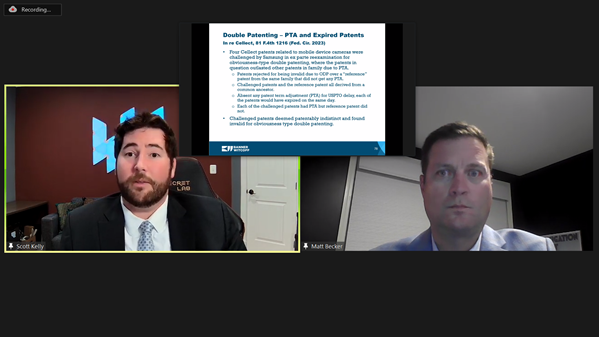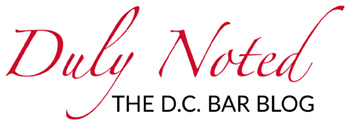Professional Growth
Patent Law Experts Recap Highlights of 2023
December 20, 2023

While the field of patent law did not experience a sea change in legal doctrine in 2023, the U.S. Court of Appeals for the Federal Circuit and the U.S. Supreme Court issued important decisions that significantly clarify the patent jurisprudence.
At the D.C. Bar CLE program “Patent Law a Year in Review” on December 13, Banner Witcoff patent attorneys Matthew P. Becker and Scott M. Kelly covered this 2023 case law and activity in the U.S. Patent and Trademark Office (USPTO), focusing on topics such as enablement, obviousness and secondary considerations for patent validity, grants of patent continuations, and challenges to the validity of patents through inter partes reviews.
Speaking to the D.C. Bar after the webinar, Kelly noted that the Federal Circuit is the sole appeals court to handle patent appeals coming from all federal district courts and from the USPTO’s Patent Trial and Appeal Board.
As such, “the U.S. Court of Appeals for the Federal Circuit is one court we can look at and say what decisions impacted patent law this year,” Kelly said. “It can be tough to keep up with throughout the year, so we aimed to take all the decisions in the year and digest it down to what are the takeaways from each of the cases.”
Kelly said these cases affect diverse practitioners, from in-house general counsel to patent prosecutors who are the focused on obtaining patents from the USPTO, as well as patent litigators who are involved with defending or asserting patent infringement allegations or challenges to a patent’s validity.
While the Federal Circuit issued impactful decisions in 2023, Kelly and Becker emphasized the importance of the one patent law case decided by the Supreme Court this year, Amgen Inc. v. Sanofi. The case involved Amgen’s two patents for antibodies that help lower low-density lipoprotein (LDL) cholesterol by inhibiting a protein that degrades LDL receptors. The company claimed coverage for a very wide grouping of antibodies and sued Sanofi for infringement. Sanofi contended the two Amgen patents claimed, “for Amgen’s exclusive use, potentially millions more antibodies than the company had taught scientists to make.”
The Supreme Court affirmed the district court and Federal Circuit decisions that sided with Sanofi, saying the Amgen patents for that wide class of antibodies did not pass the patent test of enablement, whereby a patent must be sufficiently described “to enable any person skilled in the art … to make and use the [invention].” The enablement requirement is part of “the bargain” standard for granting exclusivity to patents for 20 years, which Justice Neil Gorsuch zeroed in on in his decision, writing, “Section 112 of the Patent Act reflects Congress’s judgment that if an inventor claims a lot, but enables only a little, the public does not receive its benefit of the bargain.”
In an interview after the webinar, Becker pointed to the practical aspect of the Court’s Amgen decision, which has significant “ramifications for the pharmaceutical-drug-biotech world,” adding that “it will be difficult to claim a scope of claims for what we call functional claiming, where you claim essentially an antibody or a chemical compound or drug that performs perhaps certain functionality.”
During the program, Becker also discussed a suite of 2023 Federal Circuit cases that weighed secondary considerations, which help judges and juries weigh whether an invention is nonobvious, a cornerstone criterion for patentability. Secondary considerations are practical evidence for an invention’s impact, including resolution of longstanding industry problems, commercial success, and failure of others.
“The takeaway is that the weight the Federal Circuit has given secondary considerations and the obviousness analysis has ebbed and waned over the years,” Becker said. “For now, we are in an era again where more weight is being given to secondary considerations.”
Kelly also discussed the Federal Circuit case In re Cellect, addressing how a patent term adjustment (PTA) — granted due to USPTO delays — interacts with obviousness-type double patenting (ODP), a doctrine that prevents a later-expiring patent from having a claim that is “patentably indistinct” from a claim that expires earlier. The Federal Circuit held that ODP applied to invalidate Cellect’s patent over a related continuation patent, even though the difference in expiration dates was due only to PTA that Cellect was entitled to under the law. Cellect had argued that terminal disclaimers, which are filed to overcome double patenting issues and stipulate that two related patents will expire at the same time, should not be required to cut off duly earned PTA. The Federal Circuit disagreed, noting that the PTA statute itself mentions that PTA is subject to any terminal disclaimers.
Kelly said that while In re Cellect is complicated, the key point is that when asserting patents that are near their natural expiration date but received PTA, patent litigators should check whether any continuation in the related group of patents has created a double-patenting issue as seen in Cellect. Kelly added that he expects challenges in the continuation topic to remain in the future, especially for lawyers counseling on patent portfolios.
Kelly added that Cellect has petitioned the Federal Circuit for an en banc rehearing, supported by several large organizations. “So, this might not be the last we hear on this issue," he said.
Looking ahead, Becker said that any huge issues in patent caselaw are unlikely in 2024, but, like many other fields, new intelligence technologies will pose whole new opportunities and challenges for inventors, companies, and patent attorneys alike. “I think the impact of artificial intelligence and machine learning on patents in the future is probably going to be the big story next year,” Becker said.


